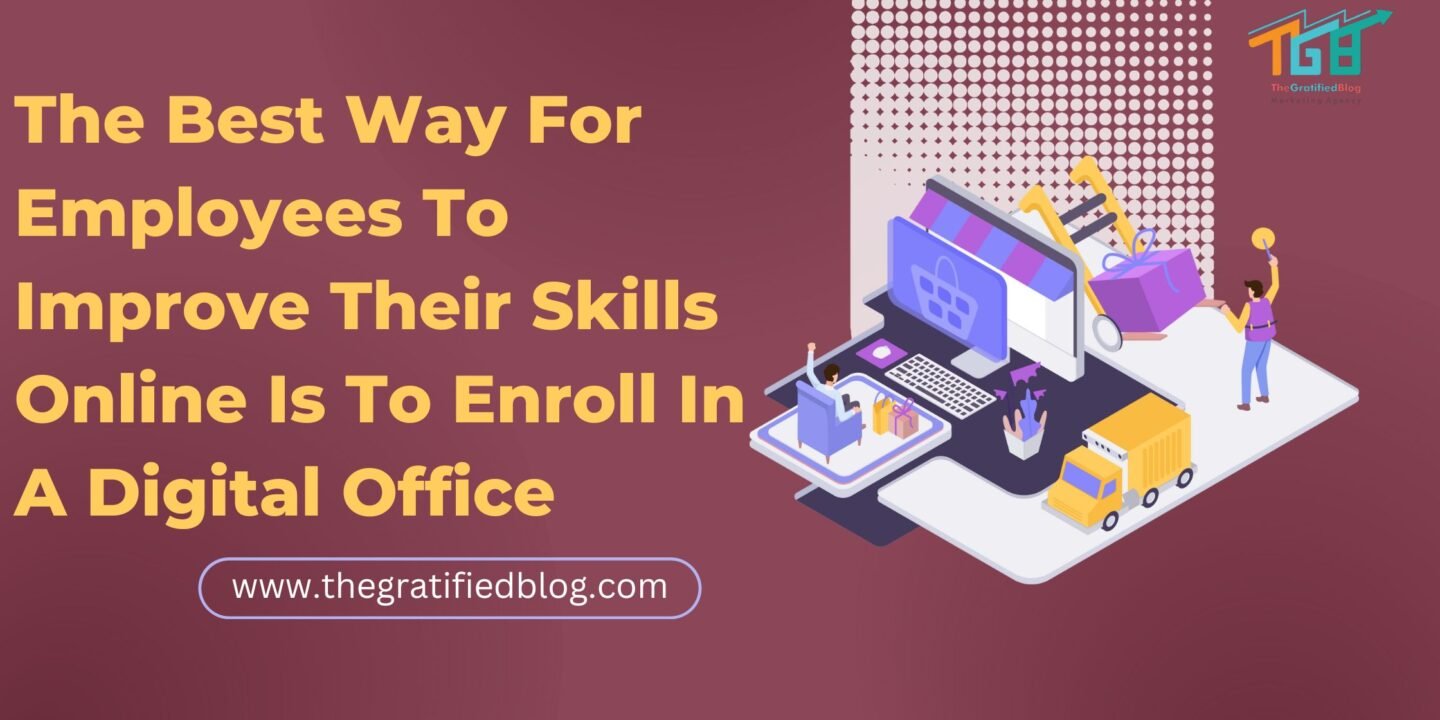
In today’s fast-paced and ever-evolving world, remaining competitive in the job market necessitates ongoing learning and skill enhancement. With the rise of digital technology, how we work and learn has experienced a significant transformation. If you’re an employee looking to enhance your skill set and stay ahead, enrolling in a digital office is the best way to achieve your goals.
In this blog post, we’ll delve into the exploration of how “The Best Way For Employees To Improve Their Skills Online Is To Enroll In A Digital Office” and how this approach can be a powerful platform for employees to improve their skills online and stay relevant in an increasingly digital-driven workforce. Let’s explore the advantages and opportunities of this innovative approach for professional growth and development.
What Is Upskilling In The Digital Age?

Upskilling in the digital age refers to acquiring new skills or improving existing ones, particularly in areas related to technology and digital tools. The digital era is marked by swift technological progress and digital transformation across various industries, making it essential for individuals to update their skill sets continually to remain competitive and adaptable. Upskilling is a response to the evolving demands of the job market, which increasingly values digital literacy and proficiency in various digital technologies.
Critical aspects of upskilling in the digital age include:
- Digital Literacy: Building a foundation of basic digital literacy is essential. This includes understanding how to use computers, smartphones, and standard software applications and navigating the internet safely and effectively.
- Technical Proficiency: Developing expertise in specific digital tools and technologies relevant to your field, such as programming languages, data analysis tools, cloud computing platforms, and industry-specific software.
- Cybersecurity Awareness: As the digital landscape expands, understanding cybersecurity best practices and risks becomes crucial to protecting personal and organizational data.
- Data Skills: Data analytics and data science skills are in high demand. Proficiency in data analysis tools, data visualization, and understanding data-driven decision-making are valuable.
- Digital Marketing: Companies heavily depend on digital marketing strategies in the digital era. Marketing professionals must understand SEO, social media marketing, content creation, and online advertising.
- AI and Automation: Gaining knowledge of artificial intelligence (AI) and automation technologies can be advantageous, as they are increasingly used in various industries for process optimization and decision support.
What Is The Best Way For Employees To Improve Their Skills Online Is To Enroll In A Digital Office?
Enrolling in a digital or virtual office environment can serve as a fantastic method for employees to enhance their skills online, especially in remote work and digital tools. Here are some practical ways for employees to enhance their skills in a digital office:
- Online Courses and Training: Utilize online platforms like Coursera, edX, LinkedIn Learning, Udemy, and others to access various courses and certifications related to digital skills, project management, communication, and more.
- Virtual Workshops and Webinars: Attend virtual workshops, webinars, and conferences related to your field or industry. These events often provide valuable insights, networking opportunities, and learning from experts.
- Digital Tools Proficiency: Focus on mastering essential digital tools used in a virtual office, such as collaboration software (e.g., Microsoft Teams, Slack, Zoom), project management tools (e.g., Trello, Asana), and productivity apps (e.g., Microsoft Office, Google Workspace).
- Soft Skills Development: Enhance soft skills like communication, time management, adaptability, and problem-solving, which are crucial in a digital office setting. Online resources and courses are available for improving these skills.
- Online Communities: Join online communities, forums, and social media groups related to your industry. Discussions and networking can help you stay updated and learn from peers.
- Podcasts and Blogs: Listen to relevant podcasts and read industry-specific blogs or news sites to stay informed about your field’s latest trends, best practices, and innovations.
- Virtual Mentoring and Coaching: Seek virtual Mentors or coaches who offer direction and feedback regarding your professional development. Platforms like MentorCruise and LinkedIn can help find mentors.
- Self-Paced Learning: Many online courses and resources allow for self-paced learning, enabling you to balance skill development with your work schedule.
- Certifications: Consider earning certifications in areas relevant to your job or career goals. Certificates can demonstrate your expertise and commitment to continuous improvement.
- Online Degree Programs: If you want more in-depth education, consider enrolling in online degree programs like master’s or graduate certificates.
- Networking: Connect with colleagues and professionals in your industry through professional networking platforms like LinkedIn. Establishing a robust professional network can unlock opportunities for skill development and career growth.
- Set Goals and Track Progress: Define clear goals for skill improvement and track your progress over time. Regularly assess your skills and adjust your learning strategies as needed.
What Are The Ways Technology Can Enhance Employee Engagement?
Utilizing technology to enhance employee engagement can be a powerful tool in various ways. Here are some strategies and examples of how Technology holds the capacity to enhance employee engagement:
- Communication and Collaboration Tools: Platforms like Slack, Microsoft Teams, and Zoom facilitate real-time communication, video meetings, and file sharing, making it easier for employees to collaborate and stay connected, especially in remote or dispersed teams.
- Intranet and Employee Portals: Intranet platforms provide a central hub for company news, resources, and updates. Employee portals can feature discussion boards, document libraries, and interactive spaces for employees to engage with each other and management.
- Feedback and Survey Tools: Anonymous feedback and surveys, often conducted through tools like SurveyMonkey or specialized employee engagement platforms, allow employees to provide input, share concerns, and offer improvement suggestions.
- Employee Recognition Software: Recognition platforms like Bonusly or Kudos enable colleagues and managers to publicly Acknowledge and incentivize employees for their accomplishments and contributions, boosting morale and motivation.
- Performance Management Software: Performance management systems offer a structured approach to goal setting, tracking progress, and providing feedback. They can improve engagement by aligning individual goals with organizational objectives.
- Learning Management Systems (LMS): LMS platforms such as Moodle or TalentLMS allow organizations to offer online courses and training, making it easy for employees to develop new skills and advance within the company.
- Gamification: Incorporating gamification elements into various tasks and processes, like onboarding or training, can make work more engaging. For example, using leaderboards or rewards for achievements can motivate employees.
- Well-being Apps: Employee well-being apps offer resources and activities that support mental and physical health, helping to reduce stress and promote work-life balance.
- Social Intranets or Employee Social Networks: Social intranet platforms, such as Yammer or Workplace by Facebook, create a social media-like environment within the organization, encouraging employees to connect, share ideas, and build relationships.
- Mobile Apps: Mobile apps can allow employees to access company resources, collaborate, and engage while on the go.
Conclusion
In today’s digital age, upskilling is vital for employees to stay competitive and adaptable in their careers. Enrolling in a digital office can be a powerful way to achieve this. The opportunities are endless, from online courses and virtual workshops to proficiency in digital tools.
To share your thoughts or experiences on this topic, we invite you to comment on our blog post and discuss how technology and digital resources can further enhance employee skills and engagement. Your insights are valuable, and we look forward to hearing from you!








No Comments